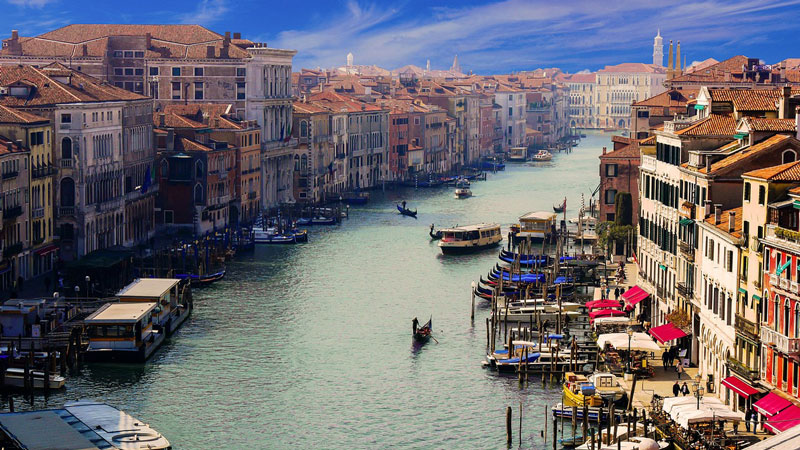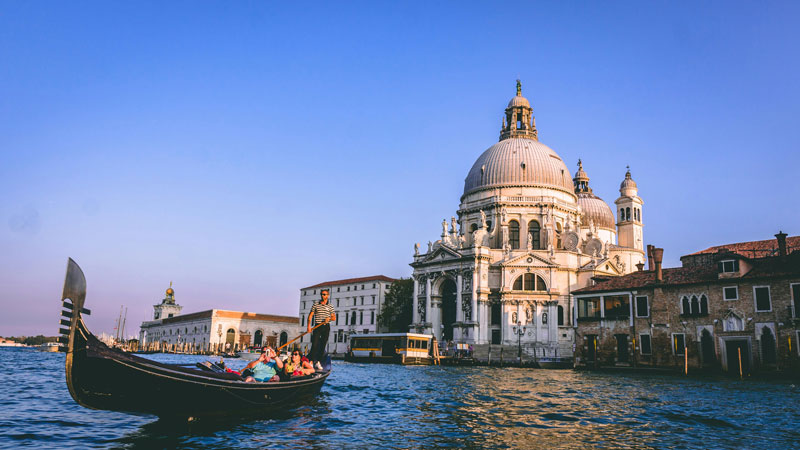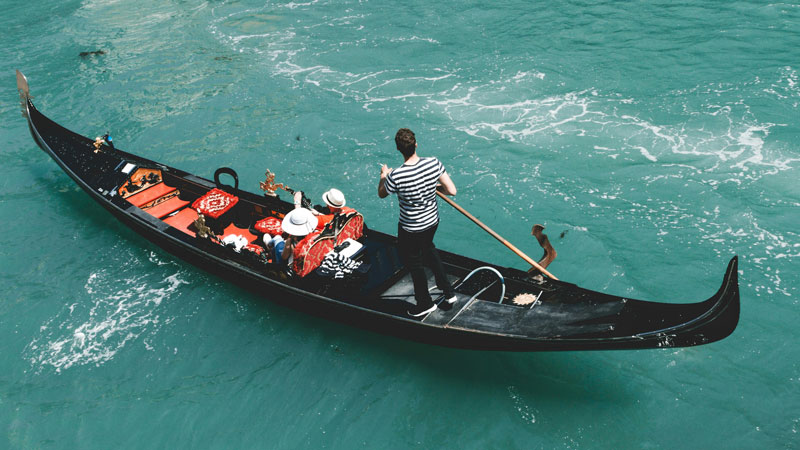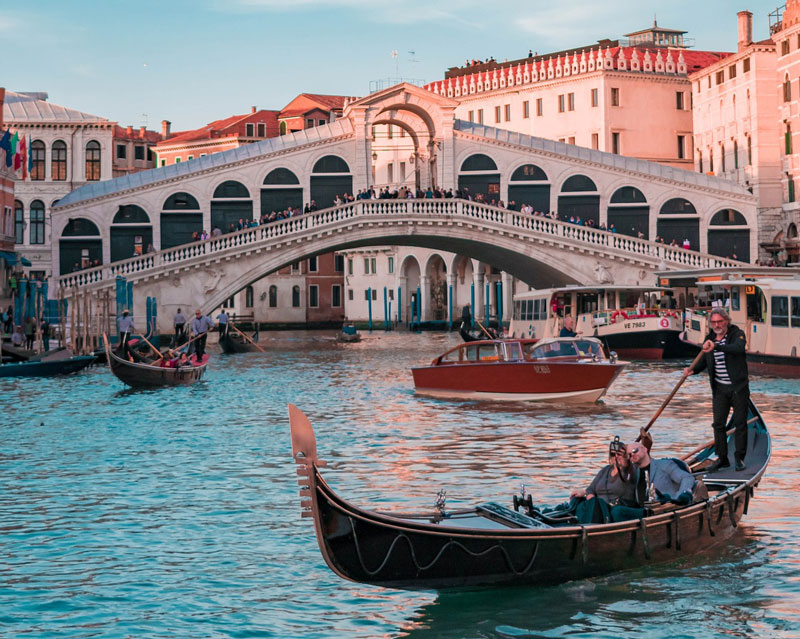Barging in Italy
All About Venetian Gondolas
Intricately designed, the elegant Venetian Gondolas are a true symbol of Venice. With just several hundred gondolas peppered around Venice today, here's everything you need to know about these iconic vessels.

Venetian Gondolas
The canals of Venice are home to a variety of vessels, ranging from the "vaporetti", public water buses run by the municipal transport system, to private motor-launch taxis, as well as the intricately carved Venetian gondolas. Other specialized craft, such as barges carrying fruit & vegetables, ambulance & police launches, and boats filled with tourists' luggage, make up a water scene of endless variety and color.
Venice's landscape is as much a product of its economic activities, past and present, as of its physical environment. The enduring foundation of Venetian wealth was its maritime commerce, initially in local products such as fish and salt from the lagoon, but rapidly expanded to include rich stores of merchandise as Venice became the midpoint between Europe, the Middle East and Asia.
Venetian trade required well-constructed vessels both for transport and for protection from pirates, rivals and Turkish military forces. Shipbuilding inevitably became a major industry and occupied a whole sector in the northeast of the city known as the Arsenal – a vast assemblage of basins, yards and workshops for making sails, ropes and ordnance.
A Symbol of Venice
The best-known form of transport is the Venetian gondola. While today there are only several hundred of these unique, keel-less boats in existence, their elegant, sleek shape and gleaming black paintwork have made them a symbol of Venice. Many writers have described the romance of a gondola ride in Venice, and tourists are still willing to pay high prices to be rowed at twilight through the canals to the lulling song of a gondolier.

Gondolas are well-suited to the conditions of the Venetian canals and lagoon, and are typically propelled by a gondolier with an oar. The uniqueness of the gondola includes it being asymmetrical along its length making the single-oar propulsion more efficient, and for centuries the gondola was a major means of transportation and the most common watercraft within Venice. Despite their gradual decline in numbers, Venetian gondolas still serve a role in the transportation of the city, albeit mainly by tourists, and continue to serve as a symbol of Venice.
Focus on the Details
Every detail of the Venetian gondola has its own symbolism. The iron prow-head of the gondola, called "fero da prorà" or "dolfin", is needed to balance the weight of the gondolier at the stern. It has an inverted "S" shape symbolizing of the twists in the Grand Canal. Under the main blade of the fero is a kind of comb with six teeth or prongs ("rebbi") pointing forward standing for the six districts or "sestieri" of Venice. The prong pointing aft symbolizes the island of Giudecca.

The fero's curved top signifies the Doge's cap. The semi-circular break between the curved top and the six teeth is said to represent the Rialto Bridge and sometimes three friezes can be seen in-between the six prongs, indicating the three main islands of the Venetian Lagoon: Murano, Burano and Torcello.
This symbolism may be "urban legend" and is likely influenced by the need to explain the shape to tourists, rather than the shape being influenced by those symbols, as they are not mentioned in any writings about the gondola prior to the current evolution of the shape of the fero.
Rowing a Venetian Gondola
The profession of gondolier is controlled by a guild which issues a limited number of licenses granted after periods of training and apprenticeship, followed by a major comprehensive exam which tests knowledge of Venetian history and landmarks, foreign language skills, and practical skills in handling the gondola. Gondoliers dress in a blue or red striped top, red neckerchief, wide-brimmed straw hat and dark pants.

The gondolier stands on the stern facing the bow, and sculls which is rowing with a forward stroke and followed by a compensating backward stroke. The oar rests in an elaborately carved wooden oarlock shaped to project from the side of the craft so as to allow even the slightest drag of each return stroke to pull the bow back to its forward course. Contrary to popular belief, they are never poled like a punt as the waters of Venice are too deep.
A Brief History of Venetian Gondolas
The Venetian gondola has existed in Venice since the 11th century and was first mentioned by name in 1094. It is estimated that there were between eight to ten thousand gondolas during the 17th and 18th centuries, but there are only around 400 in active service today.
The historical gondola was quite different from its modern form. Paintings of Canaletto and other artists show a much lower prow, a higher "fero", and usually two rowers. The banana-shaped modern gondola wasn't developed until the 19th century by the boat-builder Tramontin, whose heirs still run the eponymous boatyard. The construction of the gondola continued to evolve until the mid-20th century, when the city government prohibited any further modifications.
Until the early 20th century, gondolas were often fitted with a "felze", a small cabin to protect the passengers from the weather or from onlookers. Its windows could be closed with louvered shutters - the original "Venetian blinds". Possibly in response to complaints from tourists that it blocked their view, it was replaced by an awning, known as a "tendalin". A sumptuary law of Venice requires that Venetian gondolas be painted black, while in the past, gondolas could be many different colors.
Cost of a Gondola Ride in Venice

The cost of a Venetian gondola ride varies depending on several factors, such as location, duration, and time of day. In general, gondola rides in popular tourist destinations such as Venice, can range from 80-120 euros for a 30 to 40-minute ride. Prices may be higher during peak tourist season or for evening rides. It's always recommended to check with local gondola tour operators or online booking sites for the most up-to-date pricing information.
Cost of a Purchasing a New Gondola
Today's gondolas are up to 11 meters long and 1.6 meters wide, weighing approximately 350 kg (700lb). Made from 280 pieces of hand-made sections from eight different types of wood - including lime, oak, mahogany and walnut - a gondola can take up two months to construct. The price of a new gondola is currently somewhere in the vicinity of 40,000 euros.
Discover Venice Aboard La Bella Vita
Short video showcasing the Italian Hotel Barge La Bella Vita (3:26)
Guests of Italian Hotel Barge La Bella Vita are met in Venice. This offers the perfect opportunity to enjoy a Venetian gondola before joining the week-long barge cruise between Venice and the Renaissance city of Mantua. La Bella Vita also offers a Venetian Lagoon barge cruise. Contact Paradise Connections for more information to start planning your vacation.
Learn more about Italy
